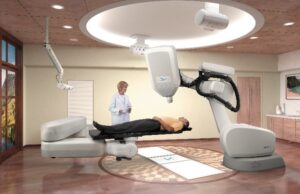Radiation for Liver Mets
 Radiation therapy can help to control the growth of liver metastases. Radiation is used primarily for patients when:
Radiation therapy can help to control the growth of liver metastases. Radiation is used primarily for patients when:
- the cancer can’t be removed with surgery.
- the tumors in the liver are too large for treatment with ablation, a technique done by our interventional radiologists.
Your treatment team will work with specialists from the medical physics department to customize a plan of care that fits your unique needs. This plan includes the latest techniques to deliver radiation directly to the tumor and minimize damage to healthy tissue.
Intensity-modulated radiation therapy and stereotactic body radiation are two approaches that can reduce damage to normal tissue being treated for liver metastases:
- intensity-modulated radiation therapy (IMRT) uses radiation beams of varying intensity that mold to the shape of the tumor. Sophisticated software and 3-D images from CT scans enable your doctor to focus radiation on cancerous tissue more precisely.
- stereotactic body radiation therapy(SBRT) uses a highly focused radiation field to deliver larger doses of radiation in fewer treatments. It combines IMRT and image-guided radiotherapy. Your doctor implants tiny markers into the tumor. A CT scan picks up the location of those markers, guiding radiation to the tumor.
- The CyberKnife System, the world’s only robotic radiosurgery system, offers a proven, non-surgical approach to the treatment of liver tumors. Throughout the treatment, the CyberKnife System’s unique real-time motion synchronization technology tracks the position of the tumor and simultaneously moves the robot to adapt the delivery of the radiation beam precisely to the moving target. Abdominal tumors, such as liver tumors, move with a patient’s respiration. Preserving as much healthy liver tissue as possible makes the ability to track, detect, and adapt for this motion critically important.
- The CyberKnife System’s robotic design and motion synchronization technology enable the delivery of radiation with extreme precision. This surgical-like precision is key to providing the best possible long-term cancer control, while minimizing dose to surrounding healthy tissues to reduce the risk of side effects and preserve liver function. CyberKnife treatment may be an ideal option for patients who cannot undergo surgery and/or whose tumors cannot be completely removed with surgery. The CyberKnife System can also be used as a bridge to transplantation.
Respiratory Gating
Because tumors and organs in the abdomen shift when you breathe, precisely delivering radiation to cancerous tissue can be challenging. Your treatment team may recommend motion-management techniques so they can more accurately target liver metastases while sparing healthy tissue.
Respiratory gating is a commonly used motion-management technique. It delivers radiation only at certain points during your breathing cycle. Abdominal compression can also help with motion management. In this technique, you wear a compression belt that applies abdominal pressure to minimize tumor movement. Researchers are also evaluating anesthesia to minimize tumor movement during radiation treatment.
Proton beam radiation therapy
Proton beam radiation therapy – (which provides more focused radiation using high-speed positively charged particles).
During PBT, protons are accelerated by a machine called a synchrotron or cyclotron. The protons’ high velocity creates high energy. This energy causes the protons to travel to the intended body depth. The protons then give in the tumour the targeted dose of radiation. There is less radiation dose outside the tumour with proton therapy. In X-rays radiation therapy, the x-rays continue to give radiation doses as they leave the body of the person, which means that radiation also affects healthy tissues in the region, which may cause side effects. This is not the case in PBT. PBT provides minimal dose to nearby healthy organs compared to X-ray therapy (XRT), which is especially pertinent for the treatment of liver cancers since the mean and low dose to the liver is among the most significant factors of radiation-induced liver disease (RILD). High-dose PBT in patients with HCC has been shown to achieve excellent long-term tumour control with minimal toxicity. Growing evidence recommends PBT in patients with unresectable cholangiocarcinoma or hepatic metastasis, especially to those with larger tumours who are unlikely candidates for XRT.




